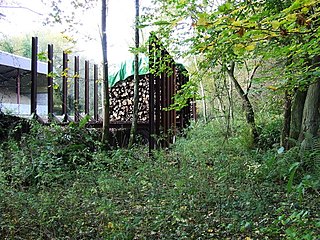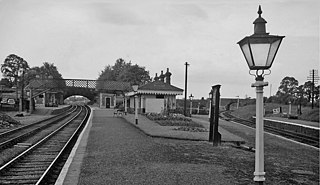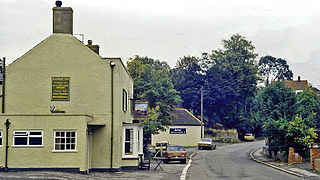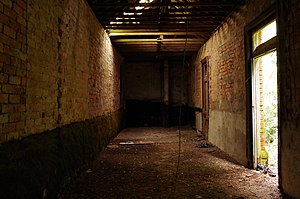
Cam and Dursley railway station is a railway station serving the village of Cam and the town of Dursley in Gloucestershire, England. It is located on the main Bristol-Birmingham line, between Yate and Gloucester, at a site close to where Coaley Junction railway station was situated from 1856 to 1965.
Andoversford and Dowdeswell railway station was on the Midland and South Western Junction Railway in Gloucestershire. The station opened to passengers on 1 August 1891 with the opening of the section of the line between Cirencester Watermoor and the junction at Andoversford with the Great Western Railway's Cheltenham Lansdown to Banbury line, which had opened in 1881.

Withington railway station was on the Midland and South Western Junction Railway serving the village of Withington in Gloucestershire. The station opened to passengers on 1 August 1891 with the opening of the section of the line between Cirencester Watermoor and the junction at Andoversford with the Great Western Railway's Cheltenham Lansdown to Banbury line, which had opened in 1881.
Chedworth Halt railway station was on the Midland and South Western Junction Railway in Gloucestershire. The station opened on 1 October 1892, 14 months after the opening of the section of the line between Cirencester Watermoor and the junction at Andoversford with the Great Western Railway's Cheltenham Lansdown to Banbury line, which had opened in 1881. Villagers at Chedworth had complained that the station provided at Foss Cross was inconvenient.

Cirencester Watermoor railway station was on the Midland and South Western Junction Railway (M&SWJR) at Cirencester in Gloucestershire. The station opened on 18 December 1883, as the terminus of the Swindon and Cheltenham Extension Railway line from Swindon Town. That line then amalgamated with the Swindon, Marlborough and Andover Railway to form the M&SWJR. Cirencester became a through-station in 1891, with the opening of the northern extension of the line between Cirencester and the junction at Andoversford with the Great Western Railway (GWR)'s Cheltenham Lansdown to Banbury line, which had opened in 1881.

South Cerney railway station was on the Midland and South Western Junction Railway in Gloucestershire. The station opened on 18 December 1883 on the Swindon and Cheltenham Extension Railway line from Swindon Town to the temporary terminus at Cirencester Watermoor. The S&CER line amalgamated in 1884 with the Swindon, Marlborough and Andover Railway to form the M&SWJR, and through services beyond Cirencester to the junction at Andoversford with the Great Western Railway's Cheltenham Lansdown to Banbury line, which had opened in 1881, started in 1891.
Cricklade railway station was on the Midland and South Western Junction Railway in Wiltshire. The station opened on 18 December 1883 on the Swindon and Cheltenham Extension Railway line from Swindon Town to the temporary terminus at Cirencester Watermoor. The S&CER line then amalgamated with the Swindon, Marlborough and Andover Railway to form the M&SWJR, and through services to the junction at Andoversford with the Great Western Railway's Cheltenham Lansdown to Banbury line, which had opened in 1881, began in 1891.

Rushey Platt railway station is a former station on the Midland and South Western Junction Railway at Rushey Platt, south west of the centre of Swindon in Wiltshire.

Swindon Town railway station was on the Midland and South Western Junction Railway at Swindon in Wiltshire. The station was sited in the Old Town area about one-and-a-half miles from the Great Western Railway's Swindon Junction.

Ogbourne railway station was on the Midland and South Western Junction Railway in Wiltshire, England. The station opened on 27 July 1881 on the Swindon Town to Marlborough section of the Swindon, Marlborough and Andover Railway. In 1883, a northwards extension, the Swindon and Cheltenham Extension Railway, opened from Swindon Town to Cirencester Watermoor, with further northward extension to a junction with the Great Western Railway's Cheltenham to Banbury line near Andoversford opening in 1891, enabling through trains from the Midlands to the south, through Ogbourne. The SM&AR and the S&CER had in 1884 amalgamated to form the M&SWJR.
Andoversford Junction railway station was in Gloucestershire on the Great Western Railway's Banbury and Cheltenham Direct Railway that opened in 1881. Situated about six miles east of Cheltenham, the station served the village of Andoversford with its large market, which provided much of the traffic at the station.

Berkeley Road railway station served the towns of Berkeley and Dursley in Gloucestershire, England.

Dursley railway station served the town of Dursley in Gloucestershire, England, and was the terminus of the short Dursley and Midland Junction Railway line which linked the town to the Midland Railway's Bristol to Gloucester line at Coaley Junction.

Cam railway station served the village of Cam in Gloucestershire, England. The station was on the short Dursley and Midland Junction Railway line which linked the town of Dursley to the Midland Railway's Bristol to Gloucester line at Coaley Junction.
The West Norfolk Junction Railway was a standard gauge eighteen and a half-mile single-track railway running between Wells-next-the-Sea railway station and Heacham in the English county of Norfolk. It opened in 1866 and closed in 1953. At Wells the line made a junction with the Wells and Fakenham Railway and at Heacham it connected with the line from Hunstanton to Kings Lynn.

Berkeley railway station served the town of Berkeley in Gloucestershire, England. The station was on the Sharpness Branch Line, part of the Midland Railway (MR), which connected the Bristol and Gloucester Railway main line at Berkeley Road station with the docks at Sharpness.
The Midland and South Western Junction Railway (M&SWJR) was an independent railway built to form a north–south link between the Midland Railway and the London and South Western Railway in England, allowing the Midland and other companies' trains to reach the port of Southampton. The M&SWJR was formed in 1884 from the amalgamation of the Swindon, Marlborough and Andover Railway and the Swindon and Cheltenham Extension Railway. The line was absorbed by the Great Western Railway at the 1923 grouping of the railways, and became part of British Railways on nationalisation in 1948. The railway closed to passengers in 1961, and to goods between 1964 and 1970. A small part of it has been reopened as the heritage Swindon and Cricklade Railway.

Fairford railway station served the town of Fairford in Gloucestershire. It was the western terminus of the Oxford, Witney and Fairford Railway between Oxford and Fairford. It had one platform, and a stone-built station building.
Wappenham was a railway station on the Stratford-upon-Avon and Midland Junction Railway (SMJ) which served the Northamptonshire village of Wappenham between 1872 and 1951. Serving a relatively rural area, the station saw considerable goods traffic generated by local farming communities, but passenger traffic was low which ultimately led to its closure.

The Cirencester branch line was a five-mile-long single-track branch railway line in Gloucestershire, England that connected Cirencester to the main line at Kemble. It was opened by the Cheltenham and Great Western Union Railway in 1841. The main line was extended from Kemble to a junction near Gloucester in 1845, by the GWR which had taken over the C&GWUR. The branch supported a busy passenger and goods business, but these declined in the 1930s, and closure was threatened in the 1950s. To reduce costs and maintain the viability of the line, lightweight four-wheel diesel railbuses were introduced, and they proved popular. Nevertheless, the line's decline was inexorable, passenger service closed in 1964 and the goods service ending the following year.













